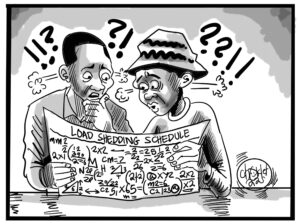A research by the Policy Monitoring and Research Centre (PMRC) shows that further growth of the country’s economy is being threatened by an electricity supply system that is increasingly showing signs of stress.
And Ministry of Energy Permanent Secretary Brigadier General Emeldah Chola has admitted that Zambia is one of the countries in Africa facing a lot of challenges in accessing affordable and reliable modern energy.
Speaking during a presentation of study findings at the launch of the PMRC interim report dubbed “The Energy Roadmap- Delivering Zambia’s Electricity Needs”, PMRC head of monitoring and evaluation Akabondo Kabechani explained that Zambia’s power sector had been facing a lot of challenges due to rising demand for electricity, insufficient capacity, power shortages and over dependence on hydro-power.
“Over the last 25 years, Zambia’s economy has been transformed. National income has more than tripled since 1990, living standards have risen and Zambia has been reclassified as a middle-income country. Economic growth is expected to be above four per cent in 2018 and the outlook for the important copper industry is buoyant after a stagnant spell. However, further progress is now threatened by an electricity system that is increasingly showing signs of stress. There are a number of challenges which include; the rising demand for electricity, on average, about three per cent per year over the period 2010-2017. Growth is largely driven by Zambia’s mining sector which accounts for more than 50 per cent. In 2010, the Ministry of Energy forecast peak electricity demand would reach 2,800 MW by 2020 rising to almost 4,000 MW by 2030. The Seventh National Development Plan (7NDP) predicts peak demand for electricity of 3,000 Mega Watts (MW) by 2021 and at least 3,525MW by 2030,” Kabechani said.
“Insufficient capacity is also another challenge, peak demand for electricity in 2017 was 2,300 MW. Nominal capacity was over 2,800 MW, not all plants are available at their full capacity all the time, and using an 80 per cet de-rating factor, the operating capacity is more in the region of 2,250 MW. Over dependence on hydro-power and vulnerability to failure of rains are other bigger challenges because Zambia is heavily reliant for electricity generation by one technology. At the end of 2016, hydro-power made up 84.5 per cent of installed capacity which was highly concentrated in three large plants. All these plants are dependent on rainfall in a single watershed. The new Itezhi-Tezhi plant is in the same watershed. In addition to the rainfall failures of 2014 and 2015 that led to recent power shortages Zambia has had previous droughts in 1991-1992 and early 2000. Modelling trends in the Basin suggests that hydro-power potential will gradually decline in future due to climate change and increasing water demand.”
Kabechani however expressed confidence that government would overcome the highlighted challenges if it stuck to its Seventh National Development Plan (7NDP) and worked together with the private sector.
“The 7NDP recognises these challenges and states; ‘largely as a result of inadequate and delayed investments in generation and transmission infrastructure and the failure to diversify energy generation sources over the last 30 years. This was further compounded by inadequate incentives to attract investment in the sector.’ As a result the Plan calls for: ‘measures to grow and diversify the energy sector to enhance its contribution to economic diversification by expanding power generation and transmission capacities’. And as noted in the 7NDP, there is widespread agreement that Zambia has plentiful resources for electricity generation, including hydro-power, solar, biomass, geothermal and coal. In principle there is a great deal of interest from companies seeking to invest in the electricity sector in Zambia; for example the February 2018 launch event of the GETFiT solar programme was oversubscribed by a factor of two,” he said.
“Zambia has as yet relatively little experience in this area. Much can be learned about how to accelerate good quality, cost-effective investment by independent power producers (IPPs) from looking at the experience – both good and bad – of neighbouring countries in Africa. PMRC has reviewed the track record of a number of countries, including Uganda, Kenya, Tanzania and South Africa. In these circumstances, there needs to be focus first on effective planning, procurement and contracting practices for new generation investment and second on ensuring the financial health of the off-taking utility.”
Meanwhile, Ministry of Energy Permanent Secretary Brigadier General Emeldah Chola said Zambia is one of the countries in Africa facing a lot of challenges in accessing affordable and reliable modern energy.
“African countries face a lot of challenges in their quest to improve the welfare of their populations, one of which is the lack of access to affordable and reliable modern energy. Africa has the lowest electrification rate of all regions. It is estimated that only 42 per cent of the African population has access to electricity, compared with 75 per cent in the developing world. In Sub-Sahara Africa, the ratio is much lower at 30 per cent and only 14 per cent in rural areas. Moreover, even when modern energy is available, it is expensive and unavailable. If current trends continue, less than half of African countries will reach universal access by 2050 and Zambia is not exempt from these problems,” Brig General Chola said.
She however, indicated that Zambia was on the right course in promoting responsive initiatives in the energy sector which would stand the test of time and serve the aspirations of the Zambian people.



















